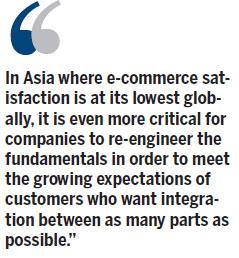Understanding omni-channel retailing in the digital age
Updated: 2014-08-21 07:11
By William Ng(HK Edition)
|
|||||||
Supply chain innovation comes in two iterations: reactive and proactive. Reactive innovation is a response to change, including unexpected change. Proactive innovation is a catalyst for change. When a leading organization gains a competitive advantage through proactive innovation, the rest of the market has to react simply to keep pace. Both types of innovation are encountered in the retail supply chain as the industry evolves rapidly from single channel to multi-channel and then to omni-channel retailing.
This year global e-commerce sales are forecast to grow by 20.1 percent to $1,500 trillion. For the first time Asian consumers' online spending is set to overtake their North American counterparts. This will make the Asia-Pacific region the world's e-commerce capital.
An in-depth study of online shopping commissioned by UPS has recently helped people better understand the e-commerce preferences of consumers and the integrated buying experience, known as omni-channel retailing. More than 4,000 online shoppers, of which 1,000 respondents were from Hong Kong, shared insights on factors which encouraged them to shop more.
In Asia where e-commerce satisfaction is at its lowest globally, it is even more critical for companies to re-engineer the fundamentals in order to meet the growing expectations of customers who want a fully integrated service. In fact only 38 percent of Hong Kong shoppers said they were satisfied, compared to 83 percent in the US and 78 percent in Europe.
The primary reason for low e-commerce satisfaction levels across Asia is the limited control consumers have over their purchase delivery preferences - namely, the flexibility to choose a delivery date, to collect purchases at a convenient retail location and to choose a specified delivery time.

It was found that online shopping satisfaction was also closely linked to the availability of tracking services. More than 55 percent of Hong Kong consumers said the ability to track shipments directly on the retailer's website was a very important criterion for completing a purchase. Text messages and e-mail notifications were also identified as useful tools for tracking packages.
Experiences during the checkout process also played a role in shoppers' decisions as to whether or not to make a purchase. Hong Kong had the highest number of shoppers (88 percent) who felt that visible reviews were a crucial deciding factor when proceeding with purchases. Nine out of 10 Hong Kong consumers also reviewed retailers' return policies before making purchases. A hassle-free returns policy not only enticed shoppers to recommend the retailer to friends (48 percent), but also encouraged them to shop more with that retailer (43 percent).
Retailers should continue to pay attention to cart abandonment as it is continuing to rise. Eight out of 10 Hong Kong shoppers admitted to having placed items in their online carts but ended up leaving sites without completing the purchase as the available delivery time-frames didn't meet their expectations. While the mainland's online shoppers expect the shortest delivery time at 7.8 days, Hong Kong consumers tend to abandon their carts at an average delivery time of nine days, compared to an average for Asia Pacific of 10 days and 15.1 days for Singapore. While there is willingness to tolerate a longer delivery time, a competitive shopping environment may lead consumers to seek alternatives if the delivery time is not satisfactory.
The omni-channel strategy many retailers are pursuing today is driven by the growth of e-commerce and consumer habits and expectations. Today's omni-channel consumers are highly-connected, well-informed and demanding; they want a seamless customer experience across all points of customer contact with retailers.
Results from the study also established that a sound omni-channel strategy, especially for Hong Kong, could actively contribute to positive growth for companies. Hong Kong shoppers were motivated to shop online when retailers integrated online purchasing with in-store pick-up, and 73 percent of shoppers had also bought other items while visiting stores to collect their online purchases. This percentage is the highest globally.
In some respects omni-channel retailing was a natural development from multi-channel retailing. It has removed barriers between channels, synchronized brand messages, and created a seamless experience to provide better service for customers. However the rapid growth of larger e-tailers, the success of mobile commerce, and changing consumer behavior accelerated the development into a reactive innovation. Retailers are discovering that they need to make significant changes to their supply chain to align merchandise and make inventory visible and available across all channels.
Global logistics companies with industry leading services and innovative technology make ideal partners for retailers looking to expand beyond a "one-channel" strategy. A strong partnership enables the optimization of supply chain operations, streamlined logistics for delivery and the management of reverse logistics - turning the last mile of the omni-channel supply chain into a competitive advantage.
The author is managing director of UPS Hong Kong and Macao.
(HK Edition 08/21/2014 page9)